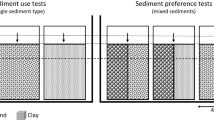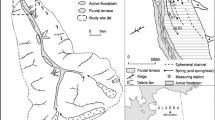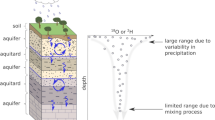Abstract
At regional and catchment scales, geology and hydrogeology strongly influence the distribution of groundwater invertebrates (stygofauna), but the fine scale distribution of stygofauna in sedimentary aquifers remains poorly studied. In this study, we examine the small-scale distribution of stygofauna in sediments of a perched aquifer in an upland swamp in south eastern Australia. We installed a series of piezometers which accessed either the full sediment profile or one of four discrete sedimentary layers in the swamp. Piezometers were sampled for stygofauna and 2H and 18O isotopes in the groundwater. The swamp contained a taxonomically diverse and abundant stygofauna, which was distributed throughout the swamp and similar in composition to that of other aquifers in the region. There were strong temporal changes in the faunal assemblages but the stimuli for these changes remain unknown. Isotope analysis indicated that the swamp water was well mixed despite localised inputs of groundwater from springs. Accordingly, we could not explore the relative influence of groundwater inputs on fauna; however, we have shown clearly that stygofauna were strongly influenced by sediment properties, with the abundance of stygofauna in the dense, fine sandy sediments being significantly lower than in the coarser sedimentary layers above and below.







Similar content being viewed by others
References
Arya, L. M. & J. F. Paris, 1981. A physicoempirical model to predict the soil moisture characteristic from particle size distribution and bulk density data. Soil Science Society of America Journal 45: 1023–1030.
Boulton, A. J., M.-J. Dole-Olivier & P. Marmonier, 2003. Optimizing a sampling strategy for assessing hyporheic invertebrate biodiversity using the Bou-Rouch method: within-site replication and sample volume. Archiv für Hydrobiologie 156: 431–456.
Boulton, A. J., P. Marmonier & P. E. X. Sarriquet, 2007. Hyporheic invertebrate community composition in streams of varying salinity in south-western Australia: diversity peaks at intermediate thresholds. River Research and Applications 23: 579–594.
Boulton, A. J., G. Fenwick, P. Hancock & M. Harvey, 2008. Biodiversity, functional roles and ecosystem services of groundwater invertebrates. Invertebrate Systematics 22: 103–116.
Bureau of Meteorology (BOM) 2016. Climate data online. Australian Bureau of Meteorology [available on internet at http://www.bom.gov.au/climate/data/index.shtml, accessed November 2016].
Camacho, A. I. & P. Hancock, 2010. A new genus of Parabathynellidae (Crustacea: Bathynellacea) in New South Wales, Australia. Journal of Natural History 44: 1081–1094.
Clarke, K. R., 1993. Non-parametric multivariate analyses of changes in community structure. Australian Journal of Ecology 18: 117–143.
Clarke, K. R. & R. H. Green, 1988. Statistical design and analysis for a ‘biological effects’ study. Marine Ecology Progress Series 46: 213–226.
Cowley, K., K. Fryirs & G. C. Hose, 2016. Identifying key sedimentary indicators of geomorphic structure and function of upland swamps in the Blue Mountains for use in condition assessment and monitoring. Catena. 147: 564–577.
Cowley K, K. Fryirs, R. Chisari & G. C. Hose, subm. Water sources and storage in Upland Swamps of Eastern NSW: implications for groundwater management and climate change. Journal of Hydrology. In review.
Datry, T., F. Malard & J. Gibert, 2005. Response of invertebrate assemblages to increased groundwater recharge rates in a phreatic aquifer. Journal of the North American Benthological Society 24: 461–477.
De Deckker, P., 2002. Australian Non-Marine Ostracoda (Crustacea) Murray Darling Freshwater Research Centre Taxonomy Workshop Presentation 1 February 2002. Murray Darling Freshwater Research Centre, Wodonga.
Eberhard, S. M., S. A. Halse & W. F. Humphreys, 2005. Stygofauna in the Pilbara region, north-west Western Australia: a review. Journal of the Royal Society of Western Australia 88: 167–176.
Freidman, B. L. & K. Fryirs, 2015. Rehabilitating upland swamps using environmental histories: a case study of the Blue Mountains Peat Swamps, Eastern Australia. Geografiska Annaler, Series A: Physical Geography 97: 337–353.
Fryirs, K., J. Gough & G. C. Hose, 2014a. The geomorphic character and hydrological function of an upland swamp, Budderoo Plateau, Southern Highlands, NSW, Australia. Physical Geography 35: 313–334.
Fryirs, K., B. Freidman, R. Williams & G. Jacobsen, 2014b. Peatlands in Eastern Australia? Sedimentology and age structure of Temperate Highland Peat Swamps on Sandstone (THPSS) in the Southern Highlands and Blue Mountains of NSW, Australia. The Holocene. 24(11): 1527–1538.
Gibert, J., J. A. Stanford, M. J. Dole-Oliver & J. Ward, 1994. Basic Attributes of Groundwater Ecosystems and Prospects for Research. In Gibert, J., D. Danielopol & J. Stanford (eds), Groundwater Ecology. Academic Press, California: 7–40.
Gibert, J., D. Culver, M. Dole-Olivier, F. Malard, M. Christman & L. Deharveng, 2009. Assessing and conserving groundwater biodiversity: synthesis and perspectives. Freshwater Biology 54: 930–941.
Glanville, K., C. Schulz, M. Tomlinson & D. Butler, 2016. Biodiversity and biogeography of groundwater invertebrates in Queensland, Australia. Subterranean Biology 17: 55–76.
Griebler, C. & M. Avramov, 2015. Groundwater ecosystem services: A review. Freshwater Sciences 34: 355–367.
Hahn, H. J., 2006. The GW-Fauna-Index: a first approach to a quantitative ecological assessment of groundwater habitats. Limnologica 36: 119–137.
Hancock, P. J. & A. J. Boulton, 2008. Stygofauna biodiversity and endemism in four alluvial aquifers in eastern Australia. Invertebrate Systematics 22: 117–126.
Hancock, P. J. & A. J. Boulton, 2009. Sampling groundwater fauna: efficiency of rapid assessment methods tested in bores in eastern Australia. Freshwater Biology 54: 902–917.
Holden, J., 2009. Flow through macropores of different size classes in blanket peat. Journal of Hydrology 364: 342–348.
Holden, J. & T. P. Burt, 2003. Hydrological studies on blanket peat: the significance of the acrotelm-catotelm model. Journal of Ecology 91: 6–102.
Hose, G. C. 2008. Stygofauna baseline assessment for Kangaloon Borefield Investigations- Southern Highlands, NSW. Report to Sydney Catchment Authority, Access Macquarie Ltd, North Ryde
Hose, G. C. 2009. Stygofauna baseline assessment for Kangaloon Borefield Investigations- Southern Highlands, NSW. Supplementary Report – Stygofauna molecular studies. Report to Sydney Catchment Authority, Access Macquarie Ltd, North Ryde.
Hose, G. C., J. Bailey, C. Stumpp & K. Fryirs, 2014. Groundwater depth and topography correlate with vegetation structure of an upland peat swamp, Budderoo Plateau, NSW, Australia. Ecohydrology 7: 1392–1402.
Hose, G. C., M. G. Asmyhr, S. J. B. Cooper & W. F. Humphreys, 2015. Down Under Down Under: Austral Groundwater Life. In Stow, A., N. Maclean & G. I. Holwell (eds), Austral Ark. Cambridge University Press, Cambridge: 512–536.
Hose, G. C., K. Symington, M. J. Lott & M. J. Lategan, 2016. The toxicity of arsenic (III), chromium (VI) and zinc to groundwater copepods. Environmental Science and Pollution Research 23: 18704–18713.
Hughes, C. E. & J. Crawford, 2013. Spatial and temporal variation in precipitation isotopes in the Sydney Basin, Australia. Journal of Hydrology 489: 42–55.
Humphreys, W. F., 2006. Aquifers: the ultimate groundwater dependent ecosystem. Australian Journal Botany 54: 115–132.
Humphreys, W. F., 2008. Rising from down under; developments in subterranean biodiversity in Australia from groundwater fauna perspective. Invertebrate Systematics 22: 85–101.
Jacobsen, G., J. Jankowski & R. S. Abell, 1991. Groundwater and surface water interaction at Lake George, New South Wales. BMR Journal of Australian Geology and Geophysics. 12: 161–190.
Korbel, K. & G. C. Hose, 2015. Water quality, habitat, site or climate? Identifying environmental correlates of the distribution of groundwater biota. Freshwater Sciences 34: 329–343.
Korbel, K., P. J. Hancock, P. Serov, R. P. Lim & G. C. Hose, 2013a. Groundwater ecosystems change with landuse across a mixed agricultural landscape. Journal of Environmental Quality 42: 380–390.
Korbel, K., R. P. Lim & G. C. Hose, 2013b. An inter-catchment comparison of groundwater biota in the cotton growing region of NW NSW. Crop and Pasture Science 64: 1195–1208.
Korbel, K., A. Chariton, P. Greenfield, S. Stephenson & G. C. Hose, 2017. Wells provide a distorted view of life in the aquifer: implications for sampling, monitoring and assessment of groundwater ecosystems. Scientific Reports. 7: 40702.
Larned, S. T., 2012. Phreatic groundwater ecosystems: research frontiers for freshwater ecology. Freshwater Biology. 57: 885–906.
Mauclaire, L., J. Gibert & C. Claret, 2000. Do bacteria and nutrients control faunal assemblages in alluvial aquifers? Archiv für Hydrobiologie 148: 85–98.
Maurice, L. & J. Bloomfield, 2012. Stygobitic Invertebrates in Groundwater – A Review from a Hydrogeological Perspective. Freshwater Reviews 5: 51–71.
Mencio, A., K. L. Korbel & G. C. Hose, 2014. River-aquifer interactions and their relationship to stygofauna assemblages: a case study of the Gwydir River alluvial aquifer (New South Wales, Australia). Science of the Total Environment 479(480): 292–305.
Morris, B. L., A. R. L. Lawrence, P. J. C. Chilton, B. Adams, R. C. Calow & B. A. Klinck, 2003. Groundwater and Its Susceptibility to Degradation: A Global Assessment of the Problem and Options for Management. Early Warning and Assessment Report Series, RS. 03-3. United Nations Environment Programme, Nairobi, Kenya.
PB, 2006. Hydrochemical and Environmental Isotope Sampling Program – Upper Nepean Groundwater Investigation Sites. Parsons Brinckerhoff, Sydney
Robertson, A. L., J. W. N. Smith, T. Johns & G. S. Proudlove, 2009. The distribution and diversity of stygobites in Great Britain: an analysis to inform groundwater management. Quarterly Journal of Engineering Geology and Hydrogeology 42: 359–368.
Schmidt, S. I. & H. J. Hahn, 2012. What is groundwater and what does this mean to fauna? – An opinion. Limnologica - Ecology and Management of Inland Waters 42: 1–6.
Schmidt, S. I., H. J. Hahn, T. J. Hatton & W. F. Humphreys, 2007. Do faunal assemblages reflect the exchange intensity in groundwater zones? Hydrobiologia 583: 1–19.
Serov, P.A., 2002. A preliminary identification of Australian Syncarida (Crustacea). MDFRC Identification Guide No.44, CRC Freshwater Ecology, Albury, NSW, Australia.
Sket, B., 2008. Can we agree on an ecological classification of subterranean animals? Journal of Natural History 42: 1549–1563.
SMEC 2006. Baseline Groundwater Dependent Ecosystem Evaluation Study –Upper Nepean Groundwater Pilot Studies – Final Report. Report to Sydney Catchment Authority. SMEC Australia Pty Ltd, Sydney.
Sorensen, J. P. R., L. Maurice, F. K. Edwards, D. J. Lapworth, D. S. Read, D. Allen, A. S. Butcher, L. K. Newbold, B. R. Townsend & P. J. Williams, 2013. Using boreholes as windows into groundwater ecosystems. PLoS ONE 8: e70264.
Stakman, W. P., 1966. The relation between particle size, pore size and hydraulic conductivity of sand separates. In Proceedings of the Wageningen Symposium. Water in the unsaturated zone, pages. International Association of Scientific Hydrology, Wageningen, The Netherlands: 373–384.
Stein, H., C. Griebler, S. E. Berkhoff, D. Matzke, A. Fuchs & H. J. Hahn, 2012. Stygoregions - a promising approach to a bioregional classification of groundwater systems. Nature Scientific Reports 2: 673.
Strayer, D.L., 1994. Limits to biological distributions in groundwater. In Groundwater Ecology. Academic Press, New York: 287–310.
Stumpp, C. & G. C. Hose, 2013. Impact of water table drawdown and drying on subterranean aquatic fauna in in vitro experiments. PLoS ONE 8(11): e78502.
Tomlinson, M. 2008. A Framework for Determining Environmental Water Requirements for Alluvial Aquifer Ecosystems. Unpublished PhD thesis, University of New England, Armidale, Australia.
WA EPA, 2007. Sampling methods and survey considerations for subterranean fauna in Western Australia, Technical Appendix to Guidance Statement No. 54, Western Australia Environmental Protection Authority, Perth.
Wells, J. B. J., 2007. An annotated checklist and keys to the species of Copepoda Harpacticoida. Zootaxa 1568: 1–872.
Zagmajster, M., D. Eme, C. Fiser, D. Galassi, P. Marmonier, F. Stoch, J. Cornu & F. Malard, 2014. Geographic variation in range size and beta diversity of groundwater crustaceans: insights from habitats with low thermal seasonality. Global Ecology and Biogeography 23: 1135–1145.
Acknowledgements
This research was funded by a Macquarie University Research and Development Grant, a grant awarded under the Department of Sustainability, Environment, Water, Population and Communities (DSEWPaC), and Australian National University (ANU) Research Program on Temperate Highland Peat Swamps on Sandstone (THPSS) and an Australian Research Council (ARC) Linkage Grant (LP130100120), all awarded to GH and KF at Macquarie University. This work was conducted under a NSW NPWS Scientific License. We are grateful for the comments of Associate Editor Stuart Halse and two anonymous reviewers which improved this manuscript.
Author information
Authors and Affiliations
Corresponding author
Additional information
Handling editor: Stuart Anthony Halse
Electronic supplementary material
Below is the link to the electronic supplementary material.
Rights and permissions
About this article
Cite this article
Hose, G.C., Fryirs, K.A., Bailey, J. et al. Different depths, different fauna: habitat influences on the distribution of groundwater invertebrates. Hydrobiologia 797, 145–157 (2017). https://doi.org/10.1007/s10750-017-3166-7
Received:
Revised:
Accepted:
Published:
Issue Date:
DOI: https://doi.org/10.1007/s10750-017-3166-7




